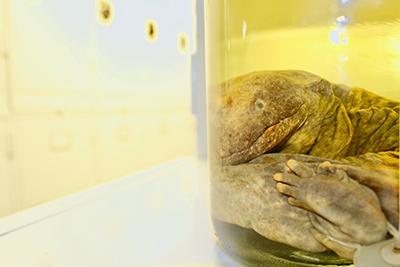
By Peyton Proffitt
Growing up in a gateway community, I spent most of my childhood summers swimming in the rivers of Great Smoky Mountains National Park. Some of my happiest memories are of looking for salamanders with my friends and sketching the specimens in my notebook. For my first Curiousity Cabinet entry, I decided to feature the biggest salamander of all: the hellbender.
Two subspecies of hellbenders (Cryptobranchus alleganiensis) are found in the United States, the Ozark and the Eastern. The Eastern hellbender resides in the streams of the Smoky Mountains, though I personally have never seen one. The specimen pictured was collected and preserved in the 1930s; its location cannot be disclosed in order to protect the remaining population.
At first glance, the hellbender could be mistaken for one of the smooth rocks found in the river, but this is actually where they make their home. These salamanders are gill-less, so they breathe through blood vessels in their skin. The rippling water that flows quickly between rocks provides oxygen. For this reason, it is important that river rocks remain undisturbed.
When rocks are moved to create cairns and dams, the hellbender’s habitat is destroyed. Freshwater Illustrated, in partnership with the U.S. Forest Service, created a short film documenting the threats to the species. You can find it HERE.
Just as we protect the things we can see in the park, like our majestic hemlocks, iconic black bears and meandering trails, it is just as important to protect those creatures we do not see, as they also play key roles in maintaining the integrity of this ecosystem. For example, hellbenders maintain crayfish in small fish populations in the streams they occupy.
Please, do your part to preserve the hellbender population in the Smokies: educate your friends and family. For more on reptiles and amphibians in the park, take a look at OUR GUIDE.
Subscribe to get the latest posts sent to your email.
The Great Smokies Welcome Center is located on U.S. 321 in Townsend, TN, 2 miles from the west entrance to Great Smoky Mountains National Park. Visitors can get information about things to see and do in and around the national park and shop from a wide selection of books, gifts, and other Smokies merchandise. Daily, weekly, and annual parking tags for the national park are also available.